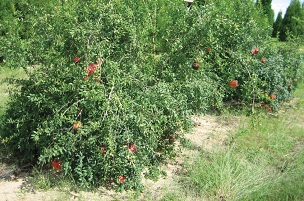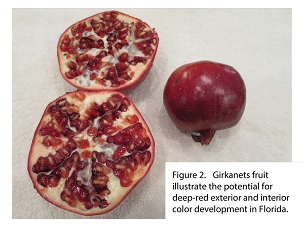Article from
VSCNews, Vegetable and Specialty Crop News
by Bill Castle and Emory McTeer
Pomegranates in
Florida - Really?
 |
Figure 1. Plants of Parfyanka at about 5
years of age in
2015 had an excellent crop of large fruit, causing many
branches to bend. |
Yes
really! Investigating the potential of pomegranates as a commercial
crop in Florida started in 2008 at the University of Florida’s Citrus
Research and Education Center (UF/CREC). At the time, greening disease
was well established in the citrus industry. Interest in alternative
crops was high. Pomegranate was identified as a crop worth exploring
partly because there were dooryard plants everywhere in Florida — some
that were 100 years old or more. Moreover, because of the efforts of
the Pom Wonderful Company in California, the fruit’s popularity had
grown immensely. Pomegranate advertising stressed the many health
benefits of the fruit and juice.
The initial efforts in Florida
were to collect and evaluate pomegranate varieties. Over 100 selections
were eventually assembled from the National Clonal Germplasm
Repository, sources in Georgia and North Carolina and from Florida
nurseries and homeowners. Those selections were propagated through the
generosity of Randy Strode at Agri-Starts Inc. in Apopka, and
eventually used to establish two mother plantings: one at the CREC and
another at Water Conserv II outside of Winter Garden.
Plants
were also provided to various cooperators. Among the original
cooperators was Harold McTeer. His family had a commercial blueberry
patch near Haines City on land previously planted with citrus. We
agreed on a trial of about 1 acre of pomegranates now consisting of 180
plants spread across 42 varieties. We started with 45 plants in 2009
spaced 10 by 18 feet. Another 135 plants were set out in 2011 with
slightly more space in-row — 12 by 18 feet — because of concerns about
plant thorniness.
2015 was a good year at McTeer Farms. 2014 was
a good year, too, but for reasons not apparent, the plants looked
beautiful and were exceptionally well-cropped in 2015. That scene was
the best evidence so far of what is possible — thus, this case history.
The
2015 story began with untrained rooted cuttings growing in 1-gallon
pots. Pomegranates were planted in a field of sandy soil and have been
easy to grow. They were allowed to develop with essentially no
training. Some varieties naturally sprouted at the soil line and formed
into multi-stemmed bushes, while others retained a single trunk and
were more tree-like in shape. The plants were kept to five to eight
stems. Some pruning was also practiced to keep the canopy open,
primarily to maintain the fruit for fresh use by limiting damage from
thorns.
Fertilizers (see “Pomegranate fertilization programs”
sidebar) have mostly been applied between late winter-early spring
through June. A total of 80 to 90 pounds of nitrogen was applied per
acre. The plants were regularly irrigated using 360-degree
microsprinklers providing 6.3 gallons per hour. Water was applied about
once every one or two weeks for two to three hours per application. It
appears that less irrigation is better. However, the 2015 and 2014
seasons were wet in the Haines City area, making it difficult to
determine how much irrigation is the right amount.
|
Pomegranate
fertilization programs
.
Four applications of 8N-6P-8K dry material between
February/March to June.
.
Monthly foliar applications of 23-0-0; about 4 pounds
of nitrogen per acre per application. The Ag
Nutrients
product by Redox Ag has urea as the nitrogen
source.
.
Three to four applicatiolns from February/March until
harvest of folia micronutrients, supplied by KeyPlex
1400, Growth Products'MicroTech Ag and various
Redox Ag products.
.
No fertilizer applied between harvest (late August-
September) and late winter/early spring.
|
The Limiting
Factor
We
weren’t far into the pomegranate project before it became obvious that
the major issue, the limiting factor, in growing pomegranates was going
to be fungal diseases. The excitement of early summer when good crops
were present on the plants usually faded to disappointment by late
summer, when nearly all of the fruit on each plant became infected with
something rendering them unmarketable.
At the beginning of the
project, a list of legal chemicals for use on pomegranates in Florida
was included on the UF/CREC website. There were virtually no chemicals
on the list suitable for fungal diseases. Fortunately, the research and
Extension team of Gary Vallad, Achala Nepal KC, Zhanao Deng and Hugh
Smith of the UF/Gulf Coast Research and Education Center in Balm
evolved along with Alicia Whidden of Hillsborough County Extension to
more formally study pest, disease and horticultural aspects of the crop.
Significant
progress regarding the diseases has been made through the efforts of
Vallad and KC, who have identified the pathogens involved and have
begun to devise and evaluate management strategies. Two
Botryosphaeriaceae species, Neofusicoccum parvum and Lasiodiplodia
theobromae, and a Colletotrichum sp. were identified as major pathogens
causing leaf spotting, stem dieback and fruit rot diseases. Field and
lab studies with existing fungicides are underway at various sites,
including McTeer Farms.
Meanwhile, at McTeer Farms, about three
applications of foliar sulfur between flowering and harvest, along with
extracts of Reynoutria sachalinensis (Regalia®), have been experimented
with to combat these diseases. Commercial product rotation was an
essential part of the management strategy.
Insects have not been
problematic, except for the leaf-footed plant bug which appears every
year, usually as the fruit approach maturity. It is an insect that can
become a serious pest if not managed. Neem oil and Pyganic® were used
in a general insect management program.

Positive
results show potential
The
preceding background information leads to the real excitement of 2015
at McTeer Farms. When I (Castle) walked around the end of the
surrounding windbreak to look at the pom planting in early August, I
was stunned. The plants were striking in their overall healthy
appearance. Virtually all of the 2009 and 2011 plants were
well-cropped, better than in any previous year (see Figure 1). Also
noteworthy was the obvious presence of red color among the fruit.
Despite our hot and humid climate in Florida, the environment did not
preclude excellent red fruit and aril coloration beginning in the
summer (see Figure 2).
Our assessments of yield, the disease
situation andf ruit characteristics continued with renewed excitement.
Our combined evaluations became the principal source of descriptive
information for a comprehensive pomegranate selection guide added in
November 2015 to the CREC website.
Our information showed that
selections such as Girkanets had the potential to yield 75 to 125 fruit
per plant of red-colored fruit with medium-soft seeds and good taste.
Girkanets is noteworthy for being a precocious bearing selection that
produces fruit consistently from year to year.
Other selections
with yields ranging from 70 to 80 fruit per plant were Kazake,
Wonderful, Al-sirin-nar and Medovyi Vahsha. All of those selections
have hard seeds except Medovyi Vahsha. Christina and Gainey Sweet fruit
and plants were markedly less affected by diseases. We also agreed on
the high ranking of selections like Azadi, which is yellow-fruited and
soft-seeded with a mild, pleasant flavor liked by nearly all who taste
it. Another precocious selection that has yielded consistently is
Salavatski. Many more details can be viewed on the website selection
guide.
Real potential for pomegranates in Florida was
demonstrated in 2015 at McTeer Farms. How that translates to commercial
opportunities is presently unknown and unproven. Nevertheless,
enthusiasm for the crop remains high in Florida. Most ventures are
small in size (a few plants to a few acres), but nurseries are
supplying plants, research is underway, national grants have been
applied for, and growers are adding to our knowledge about cultivars,
cultural practices and marketing. The best news? There now is a
pomegranate community in Florida.
The
authors wish to acknowledge the generosity and vision of Harold McTeer
(deceased) who was the cooperator with whom the project was initiated.
He was a citrus and blueberry grower and exceptional cooperator.
Bill
Castle is
professor emeritus at University of Florida’s Citrus Research and
Education Center in Lake Alfred. Emory McTeer is a citrus and blueberry grower and
pomegranate cooperator.
Pomegranate
Websites
General: www.crec.ifas.ufl.edu/extension/pomegranates
Pomegranate Selection Guide:
www.crec.ifas.ufl.edu/extension/pomegranates/pom_guide.html
|
|

